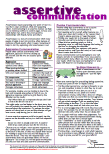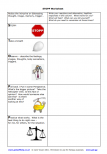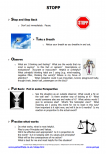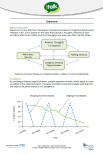Patient Area
4. Managing Fear and Frustration
Here you'll find all the worksheets and information you'll need to accompany your learning for Session 4 of our Managing Moods webinars.
What we learned this week
How fear and frustration are linked to the fight or flight response
We looked at the way our body automatically prepares us to escape dangerous situations through the 'fight or flight' response, and how this links into feeling afraid or frustrated. We learned techniques for managing those feelings, to help us feel more in control of how we respond to situations.
How to face our fears in safe situations
We talked about the way our brain learns what's dangerous through our experiences, so sometimes if we experience a situation that feels dangerous - even if we know in our mind it's safe - we can start to feel those 'fight or flight' symptoms of fear or frustration whenever we're in a similar situation again.
We learned that our body reacts in the same way to excitement or exercise as it does to danger, so it can help to remember these symptoms of fear or frustration are caused by that same 'adrenaline rush'. When we're exercising, or in an exciting situation, that adrenaline rush passes naturally without us needing to leave. Although we experience similar symptoms like our heart racing, a knot in our stomach, sweating or blushing, we feel more comfortable because we know we can cope.
So we learned a technique for teaching ourselves we can cope in those safe situations where we feel afraid or anxious.
This is called graded exposure, and has 4 principles:
We take it step by step - from the situations we're most comfortable in, working gradually towards the situations we feel most afraid in.
We stay in the situation and wait for our symptoms of anxiety or fear to reduce by half
We repeat it to build up our experiences of this situation, and teach ourselves we can cope
We don't use distractions, so that we know we can cope on our own, we don't need to rely on anything or anyone else
Resource: Use our Graded Exposure worksheet below
How to manage frustration and feel more in control
We discussed how the frustrating experiences in our day can be like shaking up a fizzy drink. The more frustration we experience, the more pressure builds up and eventually our fizzy drink could pop when we least expect it. This can cause us to react in rude or hurtful ways, when often this is the very thing we're trying to avoid by holding in our frustration.
Instead, we learned how using assertive communication can help us to resolve frustrating situations as they arise.
Generally, we tend to communicate in four ways:
Passive: We don't communicate what we want or need, and instead we accept or allow what someone else wants. We might agree and pretend we're happy with the situation when we're not, or we may simply stay quiet.
Outcome: This certainly isn't fair to you, but it can be unfair to the other person too - they won't know what they're doing is upsetting or frustrating for you, so they can't change it.Passive-Aggressive: We don't directly communicate what we want or need. Instead we pretend to accept or allow what someone else wants, whilst communicating indirectly that we're frustrated or unhappy. We might use sarcasm or humour to express how we feel, or only discuss it with other people, not the person themselves.
Outcome: This isn't fair to you as you are still experiencing this frustration, and it can cause conflict between you and the other person, or frustration for them too.Assertive: We directly communicate what we want or need, and we also listen to what the other person wants or needs.
We might use "I statements" to share how a situation affects us, without blaming the other person.
Outcome: We work together with the other person to find the fairest solution for both of us.Aggressive: We directly communicate what we want or need, but we don't listen to what the other person wants or needs.
We might use a strong tone, body language, or even raise our voice to insist on what's fair to us, without considering the other person's side.
Outcome: This certainly isn't fair to the other person, but it's also unfair to you as it can cause conflict or damage your relationships and can affect your self-esteem.
Resources:
Use the Assertive Communication factsheet below for more information and tips.
Use the STOPP Technique worksheets below if you find it difficult to respond assertively in the moment.
Downloads
STOPP Technique Worksheet (Doc)
Download to print, complete digitally or copy onto paper.
Click here to download
Graded Exposure Worksheet (Doc)
Download to print, complete digitally or copy onto paper.
Click here to download
 Menu
Menu






